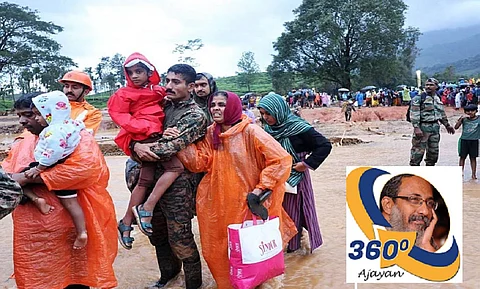

#Ajayan
As search operations in Wayanad enter their final phase, the disaster has not only unearthed massive boulders and slush, but also a cascade of controversies and formidable challenges in rehabilitating those affected by this calamity. Warnings that went unheeded, experts from science and technology institutes ordered to stay away from the disaster site, and the Chief Minister's subsequent call to revoke this order have all added to the chaos. Furthermore, there are growing comments against contributing to the CMDRF. Amidst this turmoil, the time has come for profound introspection and decisive action to restore the ecosystem and socially and economically rehabilitate the survivors. As Engels, the other prophet of the Left, remarked, there are vital lessons to be learnt from nature's revenge.
The immediate priority is the rehabilitation of the survivors of this colossal disaster. Many have lost their loved ones and homes as the landslide swept away an entire village. Returning to the village is nearly impossible, given its susceptibility to landslides. Previous landslides at Puthumala and Kavalappara occurred not far from the current site, underscoring the area's inherent danger.
Data from the Geological Survey of India reveals that between 2015 and 2022, there were 3,782 landslides, with Kerala accounting for 2,239 of them, effectively making the State a hotspot for such disasters. Additionally, the report indicates that nearly half of Kerala's landmass, encompassing 19,300 sq kms, is prone to landslides.
Research conducted at IIT-Delhi reveals that nearly 32 per cent of Wayanad is unsafe and a multi-hazard-prone area, attributed to rampant quarrying, unchecked construction activities and monocrop cultivation. A study on plantation-induced forest degradation in Wayanad, published in 2022 in the International Journal of Environmental Research and Public Health, paints an even grimmer picture. The forest cover has dwindled by 62 per cent between 1950 and 2018, leading to an astounding 1,800 per cent increase in cultivated area.
Renowned geologist CP Rajendran highlighted that the felling of trees for plantations causes the roots, which normally bind the soil, to decay, creating vast cavities. Water seeping into these cavities reaches underground channels, resulting in soil piping. This phenomenon likely occurred in the Chooralmala and Mundakkai regions, ultimately triggering the devastating landslide.
Furthermore, the felling of trees for plantations has led to the erosion of the topsoil, revealing boulders and laterite beneath which rolled down during the landslide.
Authorities attribute the landslide to the torrential downpour, which delivered a staggering 527 mm of rain in just 48 hours in Mundakkai. This deluge is not unusual in the current climate change scenario, where brief but intense rainfall now matches what was once spread over several days.
Ecologist Madhav Gadgil highlights that years of unchecked quarrying in the area have exacerbated the effects of heavy downpours in short spans. The fine dust from quarrying fills the air, increasing the aerosol load in the atmosphere and causing intense rainfall over a few hours instead of being distributed over several days. This dust not only contributes to heavy rain but also traps solar radiation, leading to various other detrimental effects.
Home Minister Amit Shah has faced accusations of misleading Parliament about issuing warnings of heavy rain in Wayanad. The counter-claims by the State, asserting that only an orange alert was given with no special warning, do not absolve them of their negligence. Compounding the issue, the Kerala State Disaster Management Authority's order barring scientists from visiting the area forced the Chief Minister into a U-turn, calling for the order’s withdrawal, and underscoring serious administrative lapses that have become all too frequent. There must be a thorough reevaluation of how this authority functions, emphasizing the need for greater grassroots engagement—an idea championed by Gadgil in his report but ignored by the authorities, pushing the populace towards a crisis.
Given these harsh realities, the government must urgently find alternative locations to relocate those who have lost everything. The hazard zone is not confined to the Chooralmala-Mundakkai region; other areas in Wayanad are equally vulnerable. Thus, the rehabilitation plan should encompass the entire district. This plan must ensure both social and economic rehabilitation, preserving the social networks of the affected people and providing them with proper livelihood sources. The Government may even need to consider reclaiming the plantations that have significantly contributed to igniting this disaster and reimagining its misguided development agenda.
How successful this endeavour will be is anyone's guess, especially considering the spectacular failure of the rebuild initiative that followed the catastrophic 2018 floods. Those in power should hear Engels whispering in its ears once more: “Thus, at every step, we are reminded that we don’t rule over Nature like a conqueror over a foreign people, as if we’re standing outside of Nature.”
